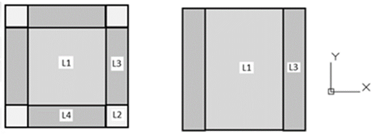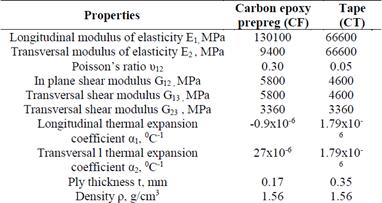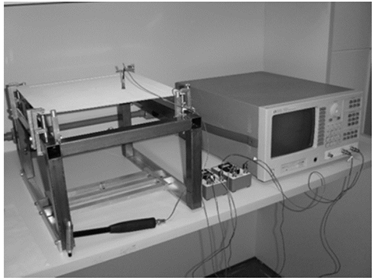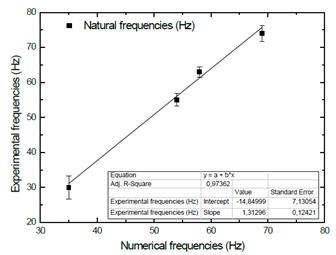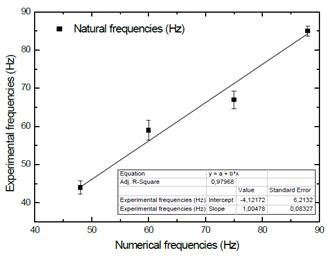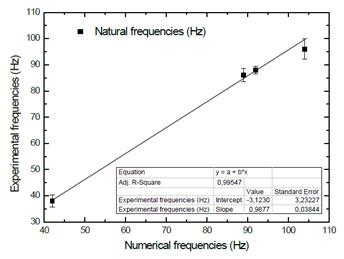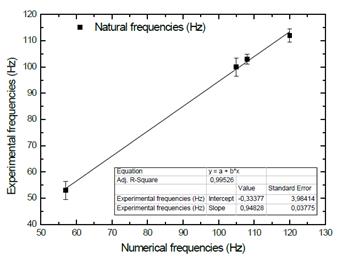1. Introduction
Structural elements made from laminated composite materials are widely used in modern industry, mainly in applications related to mechanical, civil, and aerospace engineering. However, in spite of the many advantages (high mechanical strength, low weight, etc.) of the material, it is necessary to consider that factors such as the thickness of the structural element can affect the mechanical performance, mainly in the case of laminated plates, in which the small thickness is a factor that can lead to the appearance of large amplitude oscillations in the element.
According to Naghsh and Azhari, the study of the phenomenon of free vibration that may occur in this type of structure plays an important role in structural design, because it can generate a significant increase in the strains, causing further membrane stresses, which alter the conditions of stiffness of the plate, and also can cause changes in the values of natural frequency and their characteristic modes of free vibration [1]. Due to the complexity involved in the study of the phenomenon of vibration in composite laminates and the importance of its effects on adequate structural design, this issue has aroused the interest of many researchers over the last few years.
Recently, several investigations have focused on the theoretical analysis of the problem of the free vibration of composite materials. Belytschko et al. presented a review of the theory that allowed the numerical modeling of this type of material using finite elements [2]. Quoc et al. proposed a numerical method to efficiently evaluate problems of vibration in laminated plates [3], while Ganapathi et al. presented results that analytically evaluated the free vibrations of simply supported panels [4].
Research conducted in recent years has shown that factors such as the temperature and the moisture content can play a fundamental role in the free vibration of composite laminates. Naidu and Sinha developed a formulation of finite elements that allows checking the hydrothermal effects on the determination of the frequencies of free vibrations in panels of different shape, curvature, and thickness, showing that the influence of environmental conditions on the performance of composite materials depends on the humidity levels, the temperatures acting on the material, and the geometric characteristics of the structural element [5].
Natarajan et al. presented results that report the influence of the content of humidity and the temperature gradient on the performance of composite plates. This research, carried out via the finite element method, presents results that prove that with the increase of uniform conditions of temperature and humidity, the variations in the natural frequency of free vibration do not behave linearly and can generate instability in the structural element, depending on the values of the temperature and humidity and the relationship between the width and the thickness of the plate [6].
Over the years, several studies have reported that the appearance of residual stresses associated with the curing process of composite materials may affect the mechanical performance of composites [7-10]. According to Hosseini-Toudeshky and Mohammadi, it is important to note that these stresses are the result of the inhomogeneity of the material and its anisotropic behavior, which is evident from the differences that exist in Young's modulus values and the thermal expansion coefficient of the constituent materials of the composite [11]. The residual stresses remain in the material for its lifetime and can generate adverse effects such as loss of dimensional stability, delamination, and other types of premature failure, which may place the structural integrity of an element at risk [12-15].
Almeida and Hansen introduced the idea of using the stresses that arise during the manufacturing process of composites to improve the mechanical performance of reinforced laminates and demonstrated numerically that residual thermal stresses can be used to increase the natural frequency of free vibration of reinforced plates [16]. Sanchez and Almeida reported experimental results that constitute a first approach to the mechanical characterization of laminates reinforced with different types of reinforcements, providing experimental values of the frequency of free vibration for plates with reinforcements of different types [17]. These theoretical and experimental studies served as motivation for the present study, which evaluates the effect of thermal residual stresses on the free vibration of plates with different types of reinforcements in experimental and numerical form.
For the development of this research, plates with two types of reinforcement, lateral and perimetral, were analyzed. According to the classical laminate theory [18], and taking into account that all plies that conform a laminate have an associated orientation angle, one method of presenting the sequence of the plies in symmetrical laminates is to define the laminas from the outside to the inside of the laminate, indicating with a number the angle formed by the fibers with the reference direction and, by means of a subscript, the number of consecutive laminas having this orientation. Due to the symmetry of the laminate, only the sequence of plies on one side will be expressed, and the subscript S is used to indicate that the laminate is symmetrical. A parenthesis is used to delimit the orientation of the fabric, while the use of a bracket indicates the orientation of the laminate from the outermost layer to the median plane.
The plates were prepared via the method of pre-impregnation described by Besednjak, using a fabric base consisting of four laminas oriented [(0.90)]S, on which the reinforcements were placed [19]. To induce the residual thermal stresses, two study groups were created, by varying the technique used in the process of the bonding and curing of the reinforcements. For each of the study groups, the fundamental natural frequency of free vibration and the characteristic modal forms were determined.
2. Experimental procedures
For the experimental work, a square laminate of 350 mm in width, symmetrical, of carbon/epoxy of low stiffness, and with a high coefficient of thermal expansion was used. The laminated plates were developed using a base prepreg fabric with orientation [0/90]s, on which reinforcements 35 mm wide were placed, located in different positions: lateral and perimetral (see Fig. 1). The lay-up sequences used in the laminates are shown in Table 1.
Table 1 Lay-up sequences used in the composites plates (CF is the base fabric, CT is the reinforcement and S represents the symmetry of the laminate).

Source: The authors.
Two series of laminates were studied, in which the curing conditions of the reinforcements were varied. In the first series, the laminates and their reinforcements were made independently and glued at room temperature, producing laminates reinforced without thermal residual stresses. For the second series, the laminates and the reinforcements were processed simultaneously at a high temperature and were subsequently cooled to the operating temperature, thus inducing thermal residual stresses in the material. According to Besednjak, laminates that are processed at temperatures close to 180°C are characterized by their excellent physical and mechanical properties and are widely used in the aerospace industry [19]. For this reason, it was decided to perform the processing at a temperature of 177 °C. The nomenclature used to identify the two groups of plates analyzed in the present paper is shown in Table 2.
For the elaboration of the laminate, the pre-impregnation (prepreg) technique was used. The cure process consisted of submitting a material to a cycle in an autoclave at two levels of temperatures, selected according to the suggestion of the provider of the constituent materials. The entire process of preparation of the laminate was carried out by an aeronautical company that has extensive experience in the processing of such materials. The post-curing process was not performed, in accordance with the manufacturer's recommendations. To reduce uncertainties and normalize the effects of the processing that was carried out, all the plates were prepared simultaneously and under the same conditions inside the autoclave. The curing temperature was 177 °C, which is recommended by the manufacturer for high-temperature pre-impregnated laminates. The prepreg used in the preparation of the plates was provided by the supplier Hexcel Composites and corresponds to the name T7G190-12"-F584-21: 34%. The properties of the constituent materials necessary for the development of this experiment were taken from the catalogues of the company that provided the material, and are shown in Table 3.
This experimental study allowed characterizing the dynamic behavior of the plates in terms of the determination of the natural frequencies of free vibration in order to evaluate the effect of thermal residual stresses. The tests were conducted by exciting the plates by impulsive force and measuring their response. To achieve excitation, an impact hammer model PCB 086C03 of mass 0.16 kg, 21.6 cm in length, ±2224 N measuring range pk, and resonance frequency ≥22 kHz was used. A load cell was attached to the end of the hammer to register the applied impact. To measure the response of the plate, accelerometers were placed on the plate surface. The signal captured by the accelerometers was sent to a dynamic signal conditioner model PCB 480E09, which amplified the signal and sent it to the analyzer model HP 35665 A. The analyzer received and processed signals and determined the natural frequencies of free vibration using an internal algorithm based on the use of fast Fourier transform (FFT).
The modal analysis test was divided into four stages:
Stage 1: Placement of the accelerometer at the point of excitation.
Stage 2: Excitation of the structure with a hammer. The generated signals were amplified by a dynamic signal amplifier.
Stage 3: Amplified signals were taken to the signal analyzer. This calculates the Fourier spectrum and determines the response function.
Stage 4: The excitation was repeated the predetermined number of times. The analyzer averages the value of the functions obtained in each test. In this study, 50 hammer impacts were established for each test.
In order to carry out the test, the plate was simply supported at its vertices (see Figs. 2, 3). The location of the accelerometer, as well as the point of excitation of the plate, were carefully selected so that the points did not match up with nodal plate lines, since this could impede the capture of the vibration. It should be noted that if the accelerometer or the excitement of the plate is on a nodal line, it will not be excited and therefore will not be detected during the test. For that reason, for the location of the accelerometer, the coordinates (284; 70) mm were selected for the point of impact the coordinates (70; 284) mm, taking as the origin of the reference system (x, y) the lower left edge of the studied plates. For greater accuracy in capturing free vibration modes and a decreased noise number, twelve consecutive repetitions per test were done, and the average frequency was determined. Fig. 3 shows the experimental setup of the assembly.
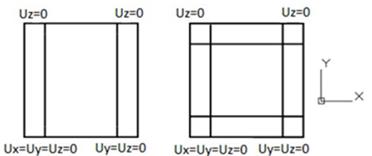
Source: The authors.
Figure 2 Boundary conditions. Displacements in relation to the reference system are represented by the letter U.
A model of numerical approximation was applied to compare the results with those obtained experimentally. The model assumes that the properties of the material are constant and that the plate is simply supported at its four vertices. ABAQUS® was used to obtain the values that allowed determining the natural frequency and its corresponding modal forms [19]. To consider the effect of the generated thermal residual stresses, a preliminary step, in which a uniform temperature field was applied to the plate without restrictions on its supports, was employed. This pre-charge condition, in addition to the geometric nonlinearity of the analyzed plates, was considered in a second stage of calculation, in which the magnitude of the eigenvalues and their characteristic modal forms were determined.
An element of type S8R was selected for the finite element mesh. This element is a shell element of a standard type, quadratic with 6 degrees of freedom for each node. The selection of the mesh was based on a convergence test. From the solution obtained for the first natural frequency of free vibration, different structured meshes were compared, changing only the number of elements. Based on the test of convergence and the processing time, a 16000-element mesh was selected.
3. Results and discussions
The amplitude as a function of the frequencies of the free vibration, obtained with the dynamic signal analyzer for the studied plates, is shown in Figs. 4 and 5. In these figures, the values that characterize the behavior of the reinforcement plates for the two-study series are shown in Table 2. Frequency peaks that characterize the first four modes of free vibration are listed for each plate (see the numbers in the figures).
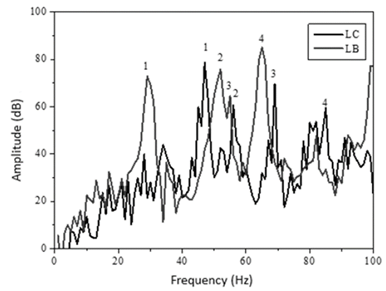
Source: The authors.
Figure 4 Frequency responses obtained experimentally for lateral reinforcement plates.
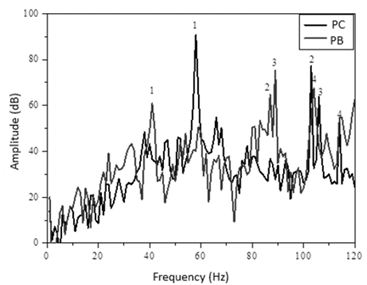
Source: The authors.
Figure 5 Frequency responses obtained experimentally for perimetral reinforcement plates.
From the experimental results shown in Figs. 4 and 5, it can be seen that the induction of thermal residual stresses in the plates generated an increase in the values of the first natural frequency of free vibration, regardless of the type of reinforcement used, resulting in an increase of approximately 40% for plates with perimetral reinforcement and about 50% for plates with lateral reinforcements. On analyzing the response spectra, similar results for natural frequencies associated with modes 2, 3, and 4 of free vibration were observed. However, the rate at which this increase in the value of certain frequencies occurs decreases for modes 3 and 4, which verifies that the increase in the stiffness of the plates in the presence of residual thermal stresses follows a non-proportional behavior. Another important aspect was determining the influence of the type of reinforcement used, showing that for the four eigenmodes found, the value of the natural frequency was higher in plates with perimetral reinforcement.
The experimental results were compared with the results obtained with the numerical model. In order to consider the residual thermal stresses, the numerical model was developed in two stages:
Step 1: Apply a uniform temperature field to determine the stresses generated.
Step 2: Calculate the first four free vibration modes and the corresponding natural frequency values. In this stage, pre-load stresses associated with those previously calculated in Step 1 are considered.
The average values were determined from the values obtained experimentally for the four modes of free vibration of the tested plates, in order to compare them with the values reported by the numerical model. The maximum error between the results was 17%. The results are shown in Tables 4, 5, 6, and 7.
Table 4 Natural frequencies of free vibration (Hz) for plates with perimeter reinforcement type "PB".

Source: The authors.
Table 5 Natural frequencies of free vibration (Hz) for plates with perimeter reinforcement type "PC".

Source: The authors.
Table 6 Natural frequencies of free vibration (Hz) for plates with perimeter reinforcement type "LB".

Source: The authors.
Table 7 Natural frequencies of free vibration (Hz) for plates with perimeter reinforcement type "LC".

Source: The authors.
The validation of the results was performed by calculating the difference between the natural frequency of the numerical and experimental models for each of the studied modes [20]. The results are shown in Table 8.
Graphical representation of the experimental results as a function of the analytical frequencies are shown in Figs. 6, 7, 8, and 9. The graph also shows a linear regression line. Due to the accumulation of errors, the points corresponding to the high frequencies exhibit greater dispersion. The graph shows how the values fit very well to the line. The linear regression lines obtained show high values of the correlation coefficient (R2( 0.97) and slope values near 1.
In order to detect possible changes in the characteristic modal forms in the numerical model, different ranges of temperatures between the service temperature (22 °C) and the processing temperature of the laminate (177 °C) were evaluated. In this way, the mapping behavior of the mode shape depending on the thermal gradient that is generated in the material was obtained. Figs. 10 and 11 show the modal forms that are characteristic for the first four modes of free vibration obtained with the numerical model at temperatures of 22 °C, 50 °C, 100 °C, and 177 °C for laterally and perimetrally reinforced plates, respectively.
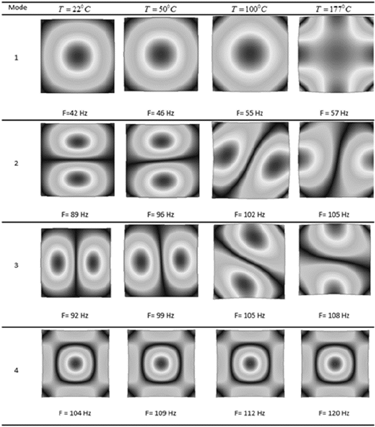
Source: The authors.
Figure 10 Characteristic mode shape depending on temperature variation for plates with perimeter reinforcement. T is the temperature and F is the frequency of free vibration.
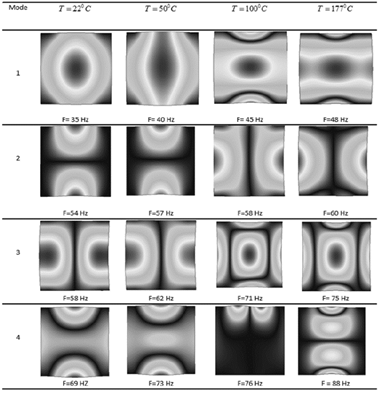
Source: The authors.
Figure 11 Characteristic mode shape depending on the temperature variation for plates with lateral reinforcement. T is the temperature and F is the frequency of free vibration.
The results shown in Fig. 10 demonstrate that the temperature variation from room temperature (22 °C) to the cure temperature (177 °C) does not generate significant changes in the mode shape that characterizes the first four modes of free vibration when reinforcement plates are placed around the perimeter. Only a modification of the mode shape that characterizes the first mode and a rotation in the mode shape associated with the second and third modes of free vibration can be seen. On the other hand, for the plates reinforced laterally (Fig. 11), variations in the characteristic mode shape were observed in all four modes analyzed.
Analyzing the variation of the natural frequencies of free vibration with the difference in the temperature, it can be seen that when generating a temperature gradient of 155 °C, an increase of approximately 35% in the characteristic value of the first natural frequency of free vibration occurred in all the plates studied, regardless of the type of reinforcement used. The increase in the other modes studied did not exceed 20% for plates with perimetral reinforcement, but can reach almost 30% on plates with lateral reinforcements. The obtained results are supported by those presented by Almeida and Hansen [16], where increases in the results determined numerically of up to 50% for the value of the first natural frequency of free vibration for reinforced graphite/epoxy laminate and about 20% for the other studied modes were reported.
From the obtained results, we can suggest that the type of reinforcement used affected the residual thermal stresses, which are distributed in the element. It was proven that upon placing a reinforcement symmetrically distributed around the plates, where the reinforcement forms a frame around the perimeter of laminate, a more uniform distribution of stress was produced when compared with stress in the plates with
lateral reinforcements. These stresses affect both the magnitude of the frequency and their characteristic mode shape; however, each vibration mode can be affected differently. It should be noted that while some vibration modes do not exhibit changes in their characteristic form, others may undergo significant variations. From the obtained results, it is possible to note that induction of residual thermal stresses in reinforcing plates can increase the properties of the structural element independently of the type of reinforcement used, this behavior being more notable in the plates reinforced around the perimeter.
4. Conclusions
The research presented in this paper shows experimentally and numerically that the presence of residual thermal stress affects the value of the natural frequencies of free vibration and the characteristic modal shape of reinforced plates. Regardless of the type of reinforcement used, the laminated plate may exhibit a notable increase in these properties when the element is simply supported.
The experimental results confirm previous research reports with respect to raising the possibility of achieving an increase in the value of the natural frequency of free vibration generated by the induction of residual thermal stresses in the material, which could be used in the design of reinforced laminates, thus improving the mechanical performance of the material or avoiding the negative effects that can be generated in it, depending on structural requirements. However, it is important to note that the proper design of composite structures requires a thorough analysis of the global behavior of the structure, in which important parameters involved are the properties of the constituent materials, the orientation of the laminas, the geometric position of the reinforcements, and the manufacturing process used. Proper selection of the temperature and the type of processing plays an important role in reducing the possible occurrence of premature failure of laminated plates.













